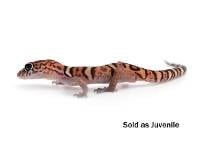Josh's Frogs
Yucatan Banded Gecko (Coleonyx elegans) Care Sheet
By Will Gyurgyik

The Yucatan banded gecko is more than just a pretty face: another one of the eyelash geckos, it also has beautiful patterns and is a hardy species.
NAME
The Yucatan banded geckos (Coleonyx elegans) hail from Mexico, Guatemala and Belize. These terrestrial geckos and live in varied habitats from rocky, arid conditions, to tropical rainforests.
COLORATION
They vary from orange red with beige and black bands and spotting when juveniles, to a beige coloration with distinctive black outlined bands of various shapes running across the body.
HOUSING
A 12x12x12 enclosure can house two to three adults. Larger enclosure can house more individuals, although males will be aggressive towards one another and should not be housed together. Substrates like Desert BioBedding, DigIt or a mixture of coco fiber and sand works well. The substrate should be kept slightly moist or drier.
Yucatan banded geckos are largely nocturnal and spend the day hiding underground. Cork bark, slate, and even everyday items like upside down plant saucers will be used by this species as hides; small commercially available reptile hides also work. Multiple hides should be provided even for a single banded gecko.
At night, these geckos will emerge to forage for insects. Rocks, low driftwood, cork bark, manzanita branches, and other similar items with rough surfaces can be provided as decor and climbing material. These geckos dig, so any heavy cage items should be directly supported by the bottom of the enclosure instead of being placed on top of the substrate.
TEMPERATURE AND HUMIDITY
This species should be kept at an ambient temperature in the mid 70’s. A daytime hot spot of around 85-90 F needs to be provided using a heat pad or bulb. Yucatan banded geckos, being nocturnal, require no special lighting.
This species spends a lot of time in humid microclimates. In addition to keeping a portion of the substrate moist, a humid hide should also be provided. A humid hide can be as simple as a piece of cork bark placed over moist substrate. Alternatively, you can provide an enclosed container with a substrate that holds moisture well, like sphagnum moss. Ambient humidity should range from 50-60%, with a higher humidity maintained within the humid hide.
Mist around 3 to 4 times a week, with the intention of moistening a portion of the substrate as well as providing water droplets on the enclosure walls, from which the geckos can drink. The enclosure should have enough ventilation such that it dries out within a few hours of misting. A shallow water dish is also recommended, but is not necessary with regular misting.
Both temperature and humidity should be monitored with a digital thermometer/hygrometer. The basking spot can be checked with an infrared thermometer or temperature gun.
SIZE
Hatchlings emerge at about 1-1.5 inches. Yucatan banded geckos reach 5 to 7 inches as adults. They have a lean build.
DIET
Yucatan banded geckos solely eat insects. Fortunately, we supply all of the insects your banded gecko will need. A staple diet of dubia roaches or crickets works best. Other food items, like small mealworms, black soldier fly larvae, or waxworms, can also be offered. A good rule of thumb for size is to only offer insects whose length does not exceed the space in between the gecko’s eyes. Generally, hatchling Yucatan banded geckos should be fed insects measuring around ⅛-inch, with subadults and adults being moved up to ¼-inch insects. Feeder insects should be gut loaded and dusted with a vitamin/mineral supplement. An escape-proof feeding dish will help keep bugs from hiding within the enclosure.
SEX
Yucatan banded gecko adults are easy to sex. Males will exhibit bulges at the base of their tail as well as clear femoral pores between their hind legs. Juveniles sold by Josh’s Frogs are too young to be sexed.
BREEDING
A brumation period in the winter is recommended to incite breeding. Females will lay pairs of eggs in the substrate. They will often deposit their eggs in a humid hide if one is provided. The eggs should be carefully removed and incubated, or else they risk becoming desiccated or dug out.
CONCLUSION
If you're interested in a medium-sized, terrestrial gecko, the Yucatan banded gecko may be a great option. Their ease of care and ability to be handled are added bonuses.

